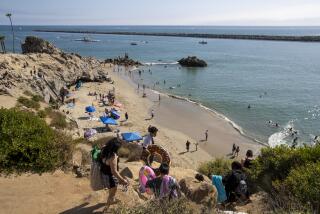‘Most Romantic Spot’ Bustles--and Remembers
- Share via
Richard Henry Dana Jr. was a college student from an upper-class Boston family who became a common seaman to sail around Cape Horn in 1835 and tell the uncommon tale in his book, “Two Years Before the Mast.”
In the book, he made only brief mention of a lonely stretch of California coastline about midway between San Pedro and San Diego called San Juan Capistrano. He was captivated, he wrote, by what the waves had wrought--but he devoted considerably more ink, even chapters, to the idyllic, tiny settlements of Santa Barbara and Monterey. Richard Dana was a perceptive forecaster of public taste.
San Juan, nevertheless, was Dana’s choice as “the only romantic spot on the coast,” a place with cliffs “twice as high as our royal masthead.” In the 1880s, a surveyor who read the book named the dominant headlands of the bluffs Dana Point.
Dana Wouldn’t Know It
But now, when many others have been bewitched by the beach, Dana wouldn’t recognize the place. Waves of development lap at the coastline. The 350-room, towered Dana Point Royce Resort Hotel, modeled after Hotel del Coronado in San Diego, is just being completed.
Inland a few blocks, on the Street of the Golden Lantern, the 169-unit Waterford Pointe residential development is under way, and a new hotel is being carved into the hillside on Pacific Coast Highway near the Street of the Crystal Lantern.
Another builder has plans for a 29-bed luxury bed and breakfast inn, turreted and ornate, near the corner of the Street of the Blue Lantern and the highway--in an area once distinctive for its warren of billboards.
The old Dana Point downtown, called La Plaza, is being renovated. An office building, called the Clocktower, is being built at one end of the district, where only tule weeds had sprouted. There are also plans for widening the center-divider park to 40 feet and adding a band shell and landscaping--and restoring and relocating the 15 lanterns that gave names to many Dana Point streets.
Among those watching the bounding growth with special interest is Margaret Miller, a member of the Dana Point Historical Society--and a great-great-granddaughter of Dana. Almost daily, she visits the brig Pilgrim, the full-scale replica of the vessel on which Dana sailed, anchored in the west end of the harbor.
She rejoices in some developments but opposes others, including a developer’s tentative plans to bring down the remains of an old hotel on the harbor cliffs and replace them with a residential development. Some memories, she says, are worth preserving--even if the crumbling ruins will clash with the posh Royce Resort Hotel just half a mile away.
The developments have triggered traffic problems, and Orange County has responded by extending the Street of the Golden Lantern 2 1/2 miles northward to connect with Crown Valley Parkway in Laguna Niguel.
Camino del Avion is being extended from its origin in San Juan Capistrano westward, connecting with and crossing the new portion of Golden Lantern and continuing westward to Crown Valley Parkway. It will also have a connection with northbound Niguel Road.
The mushrooming growth of Dana Point is occurring simultaneously with its efforts to become a city. Some residents say much of the current development seems driven by fear that strict building codes will be imposed if the city incorporates.
The plan would join Dana Point and neighboring Capistrano Beach, possibly with the communities of Monarch Bay, Monarch Beach, Monarch Terrace, Niguel Shores, Emerald Ridge and Regatta Homes.
Whether these changes come about will rest with voters in November and with the Local Agency Formation Commission next spring.
Meanwhile, Matthew Ehrhart says, the president of the Dana Point Specific Plan Board of Review, the group that passes along recommendations to the Orange County Board of Supervisors, it has been generally, if unofficially, decided that the name of the new city will be Dana Point.
It will be named, as it has been, for the sailor who more than 150 years ago found the coast barren and lonely, but romantic.
More to Read
Sign up for The Wild
We’ll help you find the best places to hike, bike and run, as well as the perfect silent spots for meditation and yoga.
You may occasionally receive promotional content from the Los Angeles Times.






